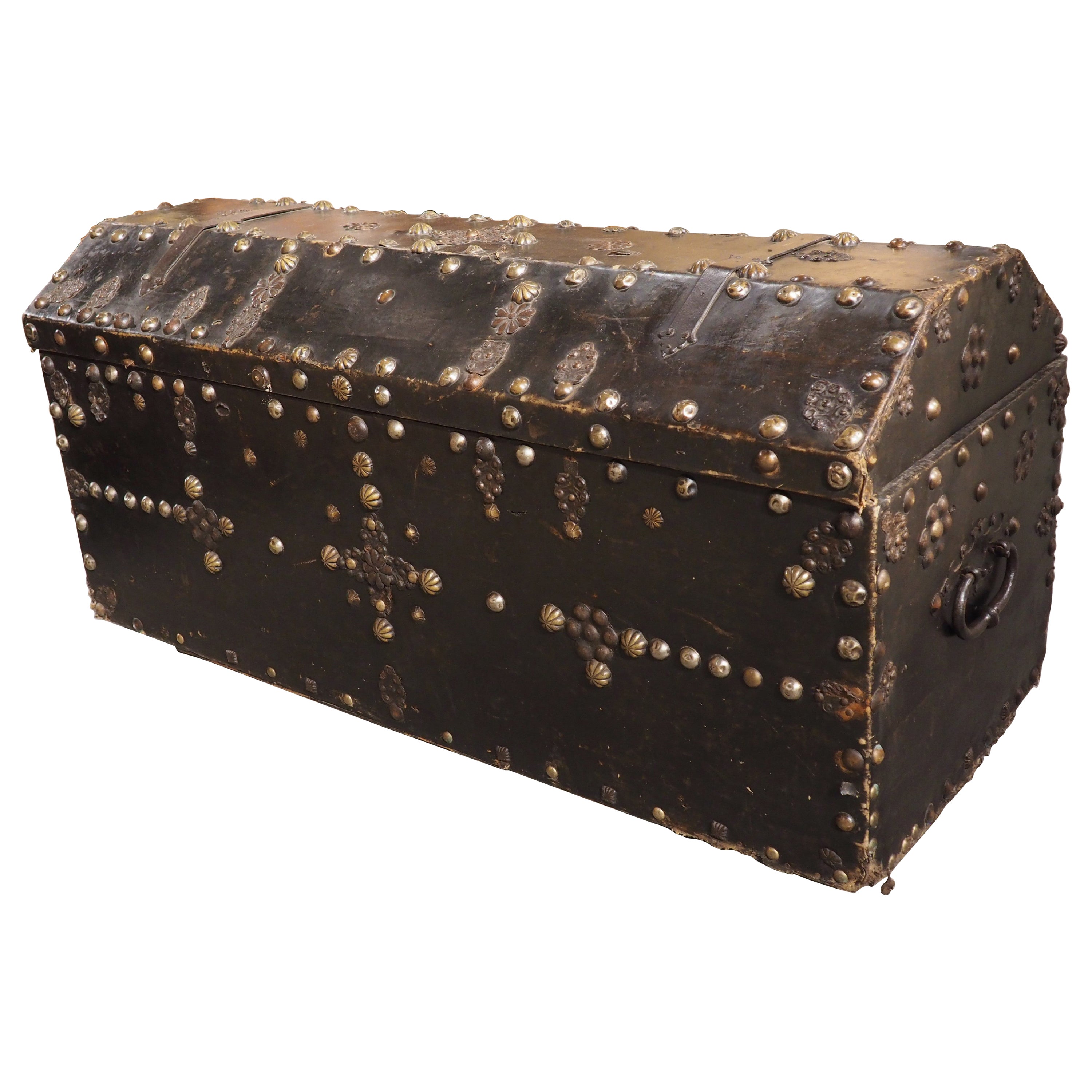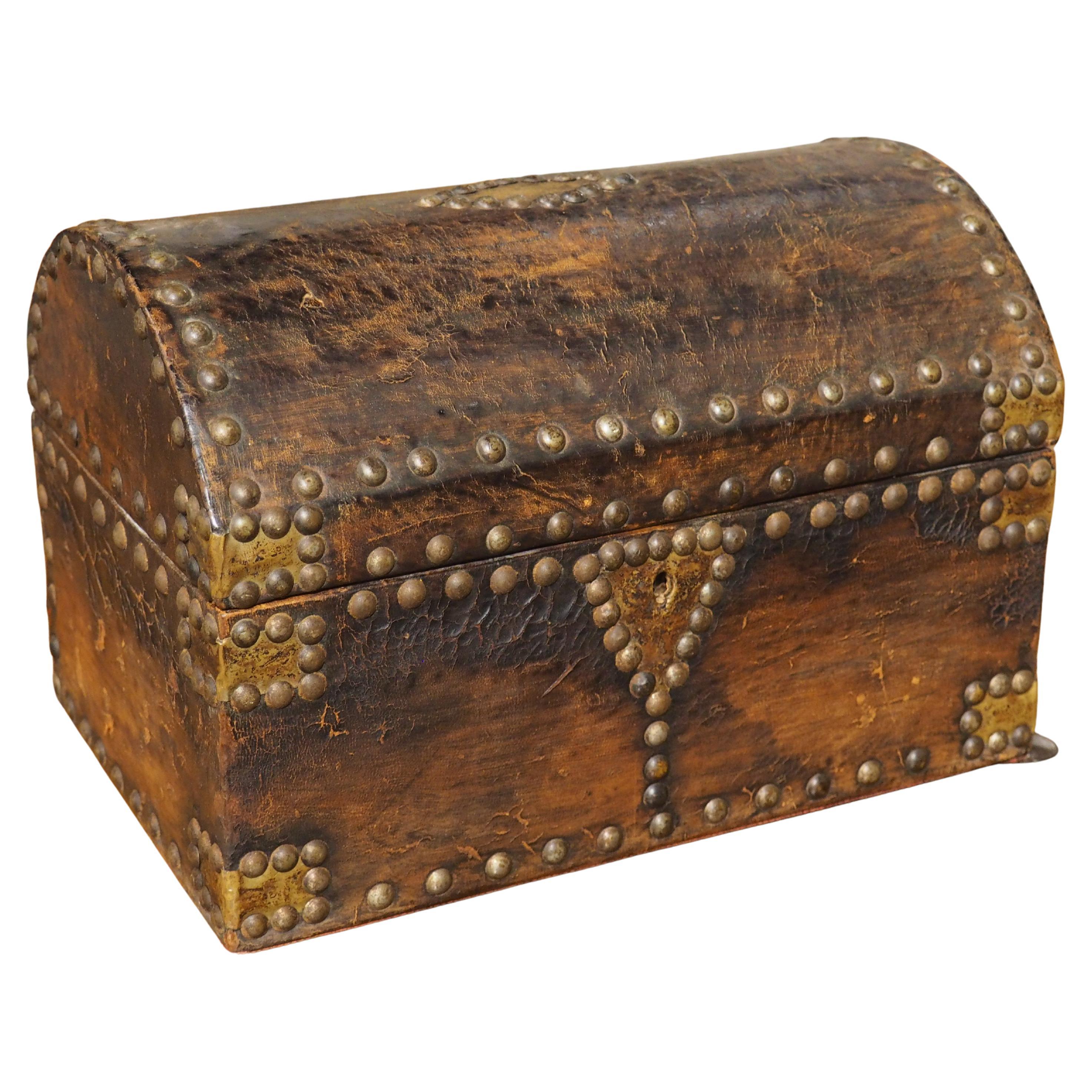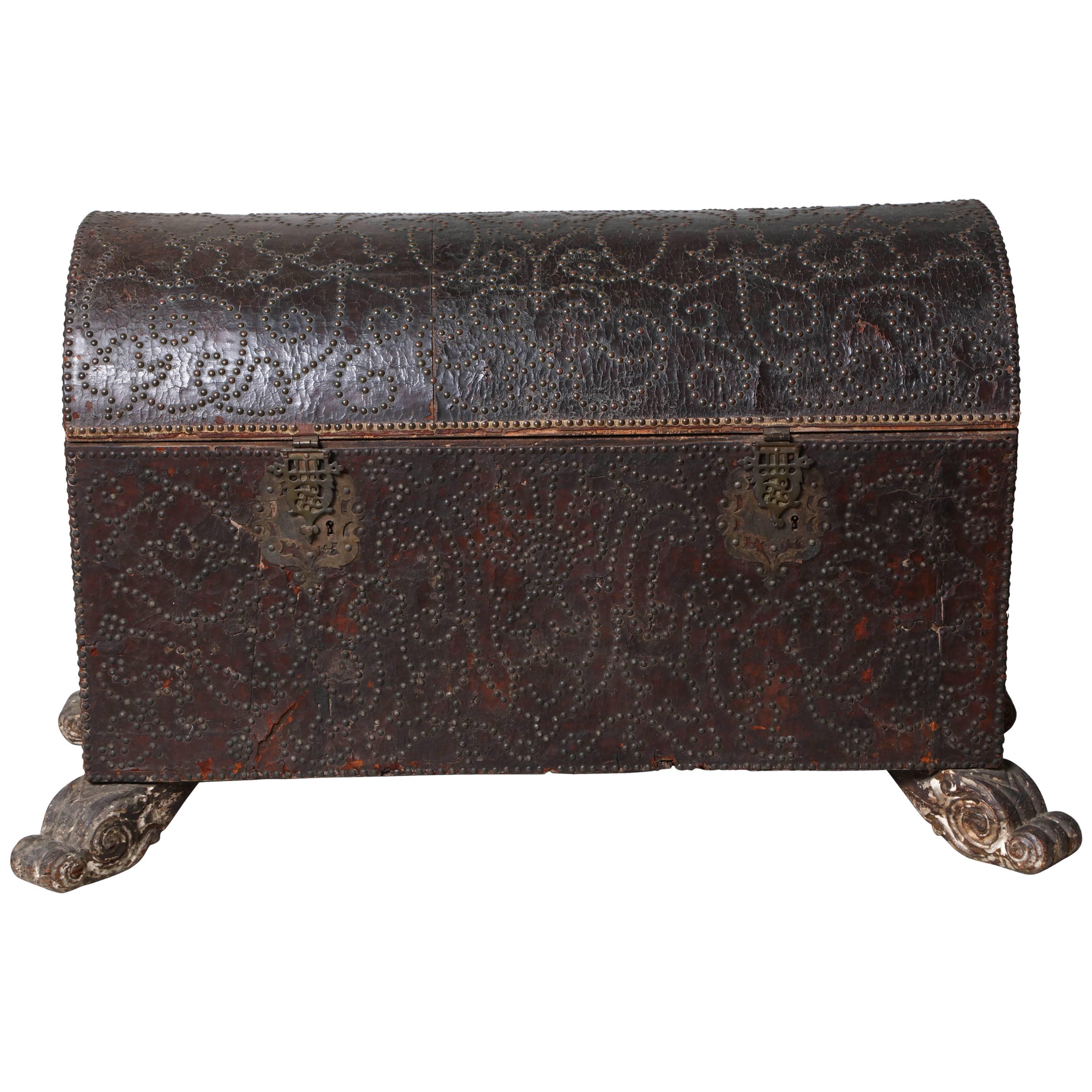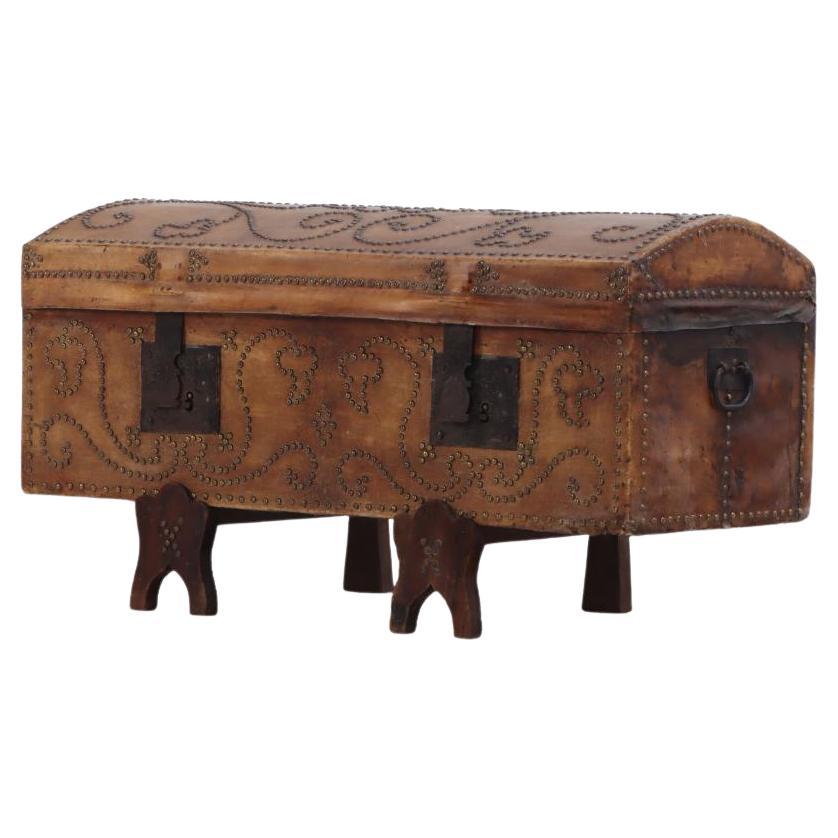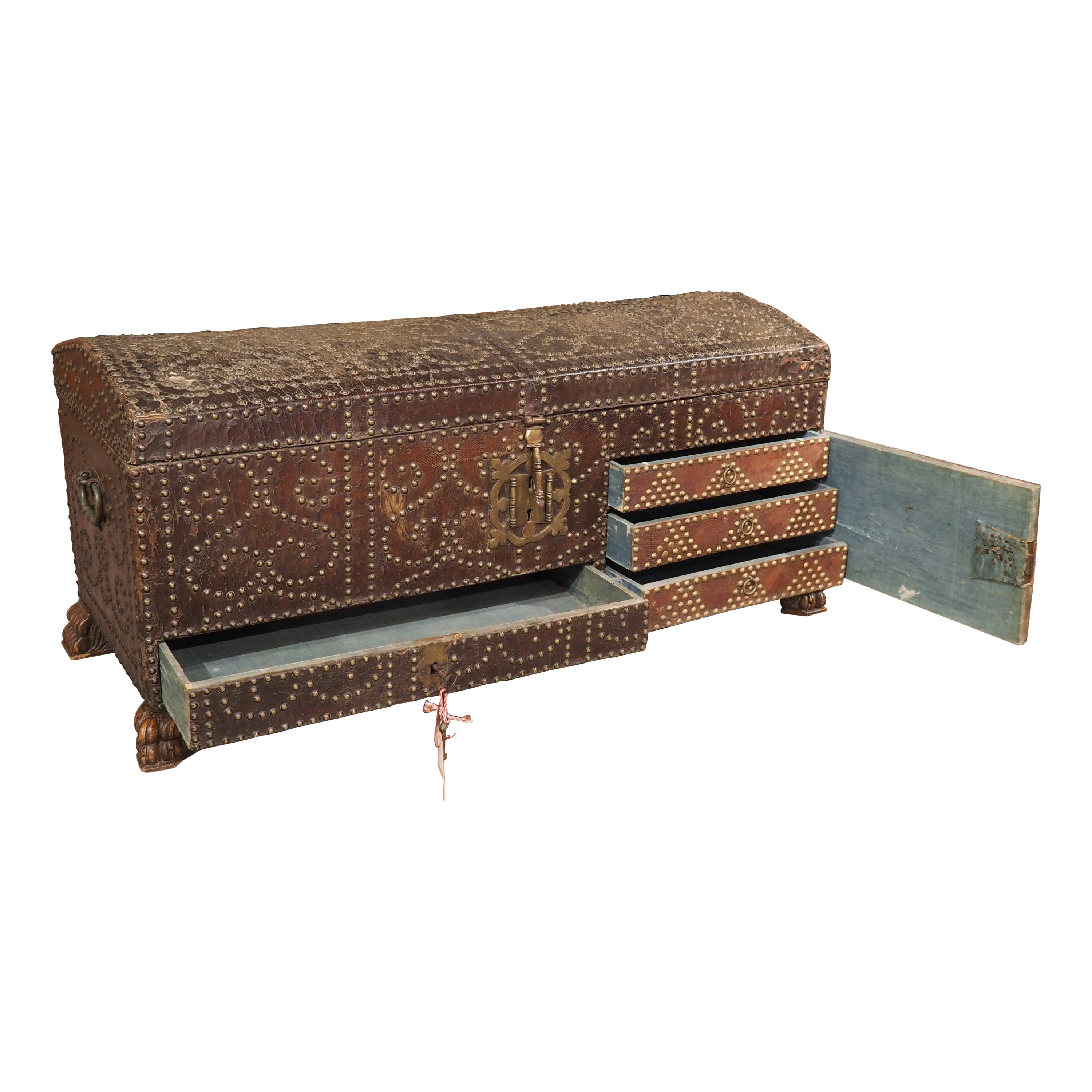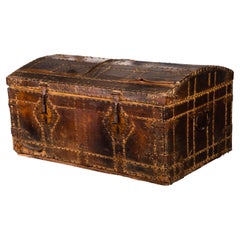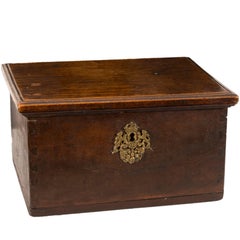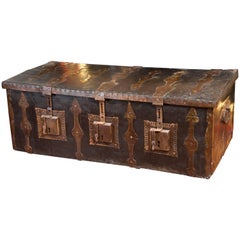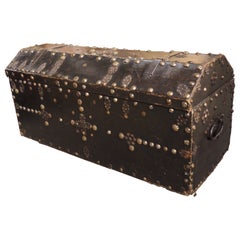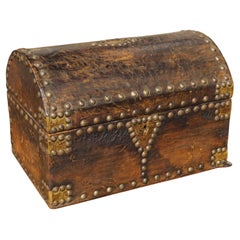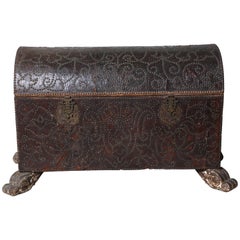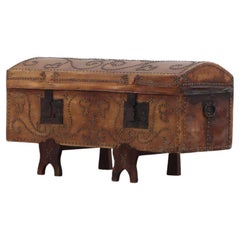Items Similar to Studded trunk. Wood, leather, metal. Spain, 18th century.
Want more images or videos?
Request additional images or videos from the seller
1 of 8
Studded trunk. Wood, leather, metal. Spain, 18th century.
$778.02
£577.25
€650
CA$1,084.69
A$1,176.03
CHF 619.76
MX$14,301.62
NOK 7,710.84
SEK 7,291.87
DKK 4,949.67
About the Item
Studded trunk. Wood, leather, metal. Spain, 18th century.
A small chest or trunk with a rectangular base and a curved lid, decorated on the outside with a leather cover and a series of metal studs forming lines and simple geometric motifs, accompanying the fittings that the piece presents. It closes at the front with a latch, has handles on the sides and the interior is made of wood in its color. ·
Size: 37x23,5x23 cm
International Buyers – Please Note: for those articles that need Export Permits (those older than 100 years), the obtaining of the Permit will be processed without additional expenses (if you choose the seller sends it to you), but the period for the obtention of it may vary from 10 to 35 days.
- Dimensions:Height: 9.06 in (23 cm)Width: 14.57 in (37 cm)Depth: 9.26 in (23.5 cm)
- Style:Neoclassical Revival (Of the Period)
- Materials and Techniques:
- Place of Origin:
- Period:
- Date of Manufacture:18th century
- Condition:Wear consistent with age and use. Minor losses. Minor structural damages. Minor fading.
- Seller Location:Madrid, ES
- Reference Number:Seller: zf12901stDibs: LU2951341339652
About the Seller
4.9
Vetted Professional Seller
Every seller passes strict standards for authenticity and reliability
Established in 1985
1stDibs seller since 2017
350 sales on 1stDibs
Typical response time: 18 hours
- ShippingRetrieving quote...Shipping from: MADRID, Spain
- Return Policy
Authenticity Guarantee
In the unlikely event there’s an issue with an item’s authenticity, contact us within 1 year for a full refund. DetailsMoney-Back Guarantee
If your item is not as described, is damaged in transit, or does not arrive, contact us within 7 days for a full refund. Details24-Hour Cancellation
You have a 24-hour grace period in which to reconsider your purchase, with no questions asked.Vetted Professional Sellers
Our world-class sellers must adhere to strict standards for service and quality, maintaining the integrity of our listings.Price-Match Guarantee
If you find that a seller listed the same item for a lower price elsewhere, we’ll match it.Trusted Global Delivery
Our best-in-class carrier network provides specialized shipping options worldwide, including custom delivery.More From This Seller
View AllTrunk. Wood, leather, iron. Spanish school, around 1700.
Located in Madrid, ES
Trunk. Wood, leather, iron. Spanish school, around 1700.
Wooden trunk with curved lid and rectangular shape, covered in leather on the outside, with hardware, handles, studs and two...
Category
Antique 18th Century Spanish Neoclassical Trunks and Luggage
Materials
Other
Chest, Leather, Wrought Iron, Textile, Wood, Spain, circa 1500
Located in Madrid, ES
Rectangular body casket with semicircular lid made of carved wood and covered with a worked leather that has been reinforced with a series of forged iron fittings, material in which ...
Category
Antique 16th Century Spanish Gothic Jewelry Boxes
Materials
Wrought Iron, Other
Walnut and Metal Small Chest, 17th Century
Located in Madrid, ES
Small rectangular ark with a flat lid, with a lock of golden metal worked (crown on two facing lions, located on a garland of great size, and all around a symmetrical composition wit...
Category
Antique 17th Century European Baroque Jewelry Boxes
Materials
Metal
Three Locks Trunk, Spain, circa 1600
Located in Madrid, ES
Trunk with three locks, made in wood, leather and wrought iron. This type of trunks and chest with three locks were very common in town halls. The decoration links the piece with the...
Category
Antique Early 17th Century Spanish Baroque Blanket Chests
Materials
Wrought Iron
Chest. Carved wood, metal. Spanish school, 16th century.
Located in Madrid, ES
Chest. Carved wood, metal. Spanish school, 16th century.
Rectangular casket with a flat lid decorated on the outside with a series of figurative reliefs in a symmetrical arrangemen...
Category
Antique 16th Century Spanish Renaissance Decorative Boxes
Materials
Metal, Other
Burgalesan Chest, Walnut, Iron, Spain, 17th Century
Located in Madrid, ES
17th Century Baroque Burgalesan Walnut and Iron Rectangular Spanish Blanket Chest
Rectangular chest with a flat lid made of carved walnut wood, with corners and bolts in front to loc...
Category
Antique 17th Century Spanish Baroque Blanket Chests
Materials
Iron
You May Also Like
18th Century Spanish Leather Trunk with Large Studded Nailhead Decoration
Located in Dallas, TX
A fantastic Spanish trunk with an angular dome top, the wood has been covered in leather on all sides except the back. The deep chocolate color leather has been affixed with various ...
Category
Antique 18th Century Spanish Trunks and Luggage
Materials
Iron
Mid 19th Century Studded Leather Table Coffret from France
Located in Dallas, TX
More information coming soon…
This small leather table coffret from France dates to the mid-1800s. The leather is affixed by numerous nailheads, with some arranged in geometrical p...
Category
Antique Mid-19th Century French Decorative Boxes
Materials
Animal Skin, Leather, Textile, Upholstery, Wood
18th Century Spanish Studded Leather Chest
Located in Greenwich, CT
Very good Spanish 18th century studded leather chest, the domed lit with Arabesque design stud work, the front with two pierced brass clasps and ...
Category
Antique Early 18th Century Spanish Baroque Blanket Chests
Materials
Brass
A Spanish studded leather domed trunk, C 1870.
Located in Philadelphia, PA
Wrapped in a light shade of leather, the metal stud decoration stands out on a trunk raised on gothic arched wooden supports. It will look wonderful on a sofa table as a hiding spot ...
Category
Antique Late 19th Century Spanish Decorative Boxes
Materials
Metal
18th Century Spanish Studded Leather Trunk with Lockable Compartments
Located in Dallas, TX
With two lockable compartments on the front façade, this studded leather trunk is a very unique storage piece. Hand-crafted in Spain during the 1700s, the trunk is well-engineered, w...
Category
Antique 18th Century Spanish Trunks and Luggage
Materials
Metal, Brass
Boiled Leather Trunk, Spanish, 17th Century
Located in Bruxelles, BE
Leather trunk
Spanish, 17th century
Boiled Leather, wood and iron
Measures: 22 x 53 x 32 cm.
Provenance :
- collection Metz-Noblat, Château de Clevant, France
Rectangular trunk of the form and size of a small suitcase with wrought iron hinges and lock-plate.
Wood, covered with leather, cut and embossed with every surface of the thick cow hide covered in interlace, zoomorphic features.
The construction method is boiled leather, often referred to by its French translation cuir-bouilli: a process used to change flexible, vegetable-tanned leather into rigid, moulded objects. For shaping of the vegetable-tanned leather, heat and moisture were used, as indicated by the term boiled leather. No written medieval sources describing the production of decorated cuir bouilli objects survive, so knowledge of the process relies on the important studies of the Scottish leather historian John William Waterer. A large range of methods, materials and techniques could be used in various combinations. The vegetable-tanned leather, made supple with moisture and heat, was stuffed, shaped and nailed to the rigid wooden coffer support. The stuffing material was probably modeled beeswax or stearin wax. To shape the leather, to create its topography, « Cushions » were made by lacing a thread through an awl hole and attaching the flexible leather and stuffing to the rigid wooden support on the bottom. Then the decoration was done: lines were incised through the upper layer of the leather (epidermis) with different thicknesses of knives or needles. Contours were created with deep v-shaped cuts, decoration with thin incision and final details with a needle point. For the incision and pouncing stage, the leather was probably kept heated and moistened for suppleness.
Once dry, the leather would be hard and rigid.
the saturated leather is worked over a form, possibly even damp sand, with the pattern shaped using bone or wooden tools. Compare to metal, leather was lighter and it offered protection from cuts and punctures. Cuir bouilli objects were produced by specialist leather workers and needed skillful craftsmanship.
The surface is filled with roundels shaped foliages enclosing animals, lions and peacocks. The foliate arabesques creating a vegetal connection tweet the animals create the impression of a lush verdant space . The vegetal pattern here employed in combination with geometrical pattern came from the pre-islamic artistic traditions of the Byzantine and Sasanian empires. An aspect of Islamic geometry Is the basic symmetrical repetition and mirroring of the shapes that create a sense of harmony.
The decoration of this truck is inspired by the islamic « arabesque » a form of vegetal ornament composed of spirals, intertwining plants and abstract curvilinear motifs. An arabesque character is given to the birds of the decorations through extreme stylisation. This arabesque maintained the classical tradition of median symmetry, freedom in Detail and heterogeneity of ornament.
The presence of the peacocks is a paradisiacal allusion: in popular Islamic literature they were among the original inhabitants of the garden of Paradise expelled with Adam and Eve. Peacock as a decorative motif may have originated in the West, despite their eastern provenance. There was an ancient belief that the flesh and feathers of peacock do not decay. This led to the peacock becoming a christian symbol for Christ’s resurrection.
Renowned for their decorative wall hangings, seventeenth-century Spanish leatherworkers also produced utilitarian objects, such as this trunk. A similar trunk is on display at the Metropolitan museum of art ( 09.158.1).
Related literature :
Davies L. 2006. Cuir bouilli. Conservation of leather and related materials, 94-102, Oxford: elsevier Butterworth-Heinemann
Grabar, Oleg. The Mediation of Ornament. Princeton: Princeton University Press, 1992
Gabriela Germana Roquez, "El mueble en el Peru en el siglo XVIII...
Category
Antique 17th Century Decorative Boxes
Materials
Iron
More Ways To Browse
18th Century Wood Furniture
Wood Trunk
Studded Furniture
Studded Leather Antique
Metal Trunk
Antique Metal Trunk
Spanish Leather Trunk
18th Century Spanish Box
Spanish Leather Box
Opaline French Boxes
Playing Card Boxes
Porcupine Quill
Stingray Skin
Tissue Box Holder
Tramp Art Wood Box
Travel Writing Desk
Amber Box
Antique Box Scottish
